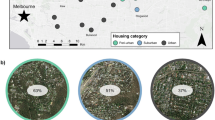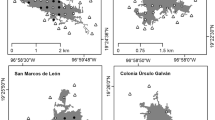Abstract
The conversion of forests and farmlands to human settlements has negative impacts on many native species, but also provides resources that some species are able to exploit. American Crows (Corvus brachyrhynchos), one such exploiter, create concern due to their impact as nest predators, disease hosts, and cultural harbingers of evil. We used various measures of crow abundance and resource use to determine crows’ response to features of anthropogenic landscapes in the Puget Sound region of the United States. We examined land cover and land use composition at three spatial scales: study sites (up to 208 ha), crow home ranges within sites (18.1 ha), and local land cover (400 m2). At the study site and within-site scales crow abundance was strongly correlated with land cover providing anthropogenic resources. In particular, crows were associated with the amount of ‘maintained forest’ cover, and were more likely to use grass and shrub cover than forest or bare soil cover. Although crows did not show a generalized response to an edge variable, they exhibited greater use of patchy habitat created by human settlements than of native forests. Radio-tagged territorial adults used resources within their home ranges relatively evenly, suggesting resource selection had occurred at a larger spatial scale. The land conversion pattern of new suburban and exurban settlements creates the mix of impervious surfaces and maintained vegetation that crows use, and in our study area crow populations are expected to continue to increase.





Similar content being viewed by others
References
Alberti M, Marzluff JM, Shulenberger E et al (2003) Integrating humans into ecology: opportunities and challenges for studying urban ecosystems. Bioscience 52:1169–1179. doi:10.1641/0006-3568(2003)053[1169:IHIEOA]2.0.CO;2
Alberti M, Weeks R, Coe S (2004) Urban land cover change analysis in Central Puget Sound. Photogramm Eng Remote Sens 70:1043–1052
Bart J, Burnham KP, Dunn EH et al (2004) Goals and strategies for estimating trends in landbird abundance. J Wildl Manag 68:611–626. doi:10.2193/0022-541X(2004)068[0611:GASFET]2.0.CO;2
Botequilha Leitao A, Ahern J (2002) Applying landscape ecological concepts and metrics in sustainable landscape planning. Landscape Urban Plan 59:65–93. doi:10.1016/S0169-2046(02)00005-1
Brown DG, Johnson KM, Loveland TR et al (2005) Rural land-use trends in the conterminous United States, 1950–2000. Ecol Appl 15:1851–1863. doi:10.1890/03-5220
Cressie NAC (1993) Statistics for spatial data. Wiley, New York
Donnelly R, Marzluff JM (2006) Relative importance of habitat quantity, structure, and spatial pattern to birds in urbanizing environments. Urban Ecosyst 9:99–117. doi:10.1007/s11252-006-7904-2
Eidson M, Kramer L, Stone W et al (2001) Dead bird surveillance as an early warning system for West Nile Virus. Emerg Infect Dis 7:631–635
Faeth SH, Warren PS, Shochat E et al (2005) Trophic dynamics in urban communities. Bioscience 55:399–407. doi:10.1641/0006-3568(2005)055[0399:TDIUC]2.0.CO;2
Gorenzel WP, Fitzhugh EL, Salmon TP (1996) Linking GIS to urban crow roost management. Trans West Sect Wildl Soc 32:48–54
Gu W, Swihart RK (2004) Absent or undetected? Effects of non-detection of species occurrence on wildlife-habitat models. Biol Conserv 116:195–203. doi:10.1016/S0006-3207(03)00190-3
Haining R (1990) Spatial data analysis in the social and environmental sciences. Cambridge University Press, Cambridge
Hansen AJ, Knight RL, Marzluff JM et al (2005) Effects of exurban development on biodiversity: patterns, mechanisms, and research needs. Ecol Appl 15:1893–1905. doi:10.1890/05-5221
Hepinstall JA, Marzluff JM, Handcock MS et al (2003) Incorporating resource utilization distributions into the study of resource selection: dealing with spatial autocorrelation. In: Huzurbazar S (ed) Proceedings of the first international conference on resource selection, Laramie, Wyoming. Omnipress, Madison, pp 12–19
Higuchi H (ed) (2003) Special Feature: conflict between crows and humans in urban areas. Glob Environ Res 7:129–206
Hogrefe TC, Yahner RH (1998) Depredation of artificial ground nests in a suburban versus a rural landscape. J Pa Acad Sci 72:3–6
Hooge PN, Eichenlaub B (1997) ANIMAL MOVEMENT extension to ArcView, version 1.1. Alaska Science Center - Biological Science Office, U.S. Geological Survey, Anchorage
Johnson DH (1980) The comparison of usage and availability measurements for evaluating resource preference. Ecology 61:65–71. doi:10.2307/1937156
Johnston RF (2001) Synanthropic birds of North America. In: Marzluff JM, Bowman R, Donnelly R (eds) Avian ecology and conservation in an urbanizing world. Kluwer, Boston, pp 49–67
Kernohan BJ, Gitzen RA, Millspaugh JJ (2001) Analysis of animal space use and movements. In: Millspaugh JJ, Marzluff JM (eds) Radio tracking and animal populations. Academic Press, San Diego, pp 125–166
LaDeau SL, Kilpatrick AM, Marra PP (2007) West Nile virus emergence and large-scale declines of North American bird populations. Nature 447:710–713. doi:10.1038/nature05829
Legendre P (1993) Spatial autocorrelation: trouble or new paradigm? Ecology 74:1659–1673. doi:10.2307/1939924
Marzluff JM (in press) Urban evolutionary ecology. Stud Avian Biol
Marzluff JM, Angell T (2005a) Cultural coevolution: how the human bond with crows and ravens extends theory and raises new questions. J Ecol Anthropol 9:67–73
Marzluff JM, Angell T (2005b) In the company of Crows and Ravens. Yale University Press, New Haven
Marzluff JM, Neatherlin EA (2006) Corvid response to human settlements and campgrounds: causes, consequences, and challenges for conservation. Biol Conserv 130:301–314. doi:10.1016/j.biocon.2005.12.026
Marzluff JM, Boone RB, Cox GW (1994) Historical changes in populations and perceptions of native pest bird species in the West. Stud Avian Biol 15:202–220
Marzluff JM, McGowan KJ, Donnelly R (2001) Causes and consequences of expanding American Crow populations. In: Marzluff JM, Bowman R, Donnelly R et al (eds) Avian ecology and conservation in an urbanizing world. Kluwer, Boston, pp 331–363
Marzluff JM, Millspaugh JJ, Hurvitz P et al (2004) Relating resources to a probabilistic measure of space use: forest fragments and Steller’s jays. Ecology 85:1411–1427. doi:10.1890/03-0114
Marzluff JM, Withey JC, Whittaker KA et al (2007) Consequences of habitat utilization by nest predators and breeding songbirds across multiple scales in an urbanizing landscape. Condor 109:516–534. doi:10.1650/8349.1
Marzluff JM, Shulenberger E, Endlicher W et al (2008) Urban ecology, an international perspective on the interactions between humans and nature. Springer, New York
McGarigal K, Marks B (1995) FRAGSTATS: spatial analysis program for quantifying landscape structure. In: General Technical Report PNW-GTR-351. USDA Forest Service, Portland
Meyer WB, Turner BL (1992) Human population growth and global land-use/cover change. Annu Rev Ecol Syst 23:39–61. doi:10.1146/annurev.es.23.110192.000351
Miller JR, Hobbs RJ (2002) Conservation where people live and work. Conserv Biol 16:330–337. doi:10.1046/j.1523-1739.2002.00420.x
Millspaugh JJ, Nielson RM, McDonald L et al (2006) Analysis of resource selection using utilization distributions. J Wildl Manag 70:384–395. doi:10.2193/0022-541X(2006)70[384:AORSUU]2.0.CO;2
Neatherlin EA, Marzluff JM (2004) Responses of American Crow populations to campgrounds in remote native forest landscapes. J Wildl Manag 8:708–718. doi:10.2193/0022-541X(2004)068[0708:ROACPT]2.0.CO;2
Odell EA, Knight RL (2001) Songbird and medium-sized mammal communities associated with exurban development in Pitkin County, Colorado. Conserv Biol 15:1143–1150. doi:10.1046/j.1523-1739.2001.0150041143.x
Odell EA, Theobald DM, Knight RL (2003) Incorporating ecology into land use planning: the songbirds’ case for clustered development. J Am Plann Assoc 69:72–82. doi:10.1080/01944360308976294
Oleyar MD, Greve AI, Withey JC et al (2008) An integrated approach to evaluating urban forest functionality. Urban Ecosyst 11:289–308. doi:10.1007/s11252-008-0068-5
Pecoraro HL, Day HL, Reineke R et al (2007) Climatic and landscape correlates for potential West Nile virus mosquito vectors in the Seattle region. J Vector Ecol 32:22–28. doi:10.3376/1081-1710(2007)32[22:CALCFP]2.0.CO;2
Robinson L, Newell JP, Marzluff JM (2005) Twenty-five years of sprawl in the Seattle region: growth management responses and implications for conservation. Landscape Urban Plan 71:51–72. doi:10.1016/j.landurbplan.2004.02.005
Roos S, Part T (2004) Nest predators affect spatial dynamics of breeding red-backed shrikes (Lanius collurio). J Anim Ecol 73:117–127. doi:10.1111/j.1365-2656.2004.00786.x
Sauer JR, Hines JE, Fallon J (2005) The North American Breeding Bird Survey, results and analysis 1966–2004. Version 2005.2. In, vol. 2006. USGS Patuxent Wildlife Research Center, Laurel, MD
Schaefer JM (1983) The common crow as a sentinel species of rabies in wildlife populations. Ph.D. thesis, Iowa State University, Ames, IA
Shirota Y (1989) A new method to scare crows Corvus macrorhynchos and C. corone. Bird Behav 8:1–7
Shochat E, Warren PS, Faeth SH et al (2006) From patterns to emerging processes in mechanistic urban ecology. Trends Ecol Evol 21:186–191. doi:10.1016/j.tree.2005.11.019
Silverman BW (1986) Density estimation for statistics and data analysis. Chapman and Hall, London
SPSS (2001) Rel. 10.1.3 Statistical Package for Social Sciences. SPSS Inc, Chicago
R Development Core Team (2005) R: a language and environment for statistical computing, 2.2.1 edn. R Foundation for Statistical Computing, Vienna
Verbeek NAM, Caffrey C (2002) American Crow (Corvus brachyrhynchos). In: Poole A, Gill F (eds) The birds of North America, vol 647. The Birds of North America, Inc., Philadelphia
Vitousek PM, Mooney HA, Lubchenco J et al (1997) Human domination of Earth’s ecosystems. Science 277:494–499. doi:10.1126/science.277.5325.494
Walford N (2002) Geographical data: characteristics and sources. Wiley, West Sussex
Wilcove DS (1985) Nest predation in forest tracts and the decline of migratory songbirds. Ecology 66:1211–1214. doi:10.2307/1939174
Withey JC (2002) Dispersal behavior of juvenile American Crows and the relationship of crow populations to human population density. In: College of Forest Resources. University of Washington, Seattle
Withey JC (2006) Interactions among American Crows, breeding songbirds, and forest function, and their responses to urbanization. Ph.D. thesis, College of Forest Resources, University of Washington, Seattle
Withey JC, Marzluff JM (2005) Dispersal by juvenile American Crows influences population dynamics across a gradient of urbanization. Auk 122:205–221. doi:10.1642/0004-8038(2005)122[0205:DBJACC]2.0.CO;2
Worton BJ (1989) Kernel methods for estimating the utilization distribution in home-range studies. Ecology 70:164–168. doi:10.2307/1938423
Zar JH (1996) Biostatistical Analysis, 3rd edn. Prentice Hall, Upper Saddle River
Acknowledgments
JW was supported during this study by a NSF Graduate Research Fellowship and Integrative Graduate Education and Research Traineeship. The research was funded by The National Science Foundation (DEB-9875041, IGERT-0114351, BCS-0120024 and BCS-0508002). R Seguine, J Mencher, L Pascoe, and E West contributed their field work and data entry. J Hepinstall assisted with analyses in ArcGIS and obtained land cover classifications and high-resolution orthophotos. P Hurvitz added the focal zone count to FOCAL PATCH and helped troubleshoot in ArcView. M Handcock wrote and advised us on using the RUF function in R. Three reviewers and the Landscape Ecology editors provided important comments and revisions that improved the manuscript. We also want to acknowledge the support of the late Bob Reineke as an Urban Ecology colleague, fellow corvid researcher, and friend.
Author information
Authors and Affiliations
Corresponding author
Electronic supplementary material
Below is the link to the electronic supplementary material.
Rights and permissions
About this article
Cite this article
Withey, J.C., Marzluff, J.M. Multi-scale use of lands providing anthropogenic resources by American Crows in an urbanizing landscape. Landscape Ecol 24, 281–293 (2009). https://doi.org/10.1007/s10980-008-9305-9
Received:
Accepted:
Published:
Issue Date:
DOI: https://doi.org/10.1007/s10980-008-9305-9




